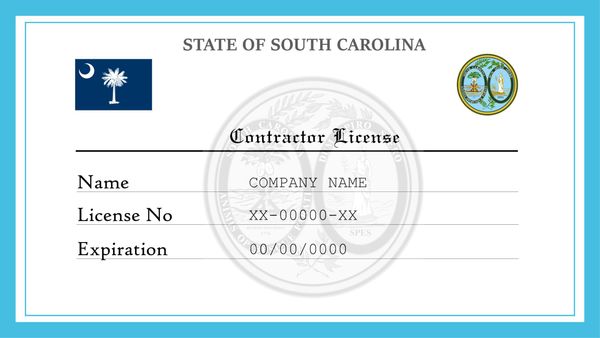
South Carolina Contractor License Classifications
Each state of the US has its own contractor license classifications. The State of Carolina is not an exception, as well.
First of all, if you want to apply for a South Carolina contractor license, you may contact the South Carolina Contractor’s Licensing Board. The Board regulates the license, registration, or certification of general and mechanical contractors, fire sprinkler contractors. It also regulates burglar alarm and fire alarm contractors, construction managers, and the boiler safety program.
The South Carolina Contractor license classifications and sub-classifications
There are many types of contractor license classifications in the State of South Carolina. Below you can find South Carolina contractor license classifications and sub-classifications:
(1) General Contractors-Building
General Contractor classification includes industrial, commercial, modular, institutional, and also all different types of building construction, counting residential structures.
The work under the following sub-classifications is included in this license classification:
- Interior Renovation
- General Roofing
- Pre-engineered Metal Buildings
- Structural Shapes
- Wood Frame Structures-Class II, and
- Masonry
People who are licensed under this classification may do subordinate work. It includes evaluating the structure or design that the licensed person has been occupied to develop.
Nonetheless, if a program incorporates work being done under a Mechanical Contractor sub-classification, the licensed person must obtain the corresponding license in order to do the following work:
- Bridges
- Tunneling
- Boring
- Specialty Roofing
- Swimming Pools
- Pipe Lines
- Sewer and Water Lines
- Railroad Lines
- Asphalt Paving
- Marine, and
- Sewer and Water Plants.
(2) General Contractors-Public Utility
It incorporates work under the following sub-classifications:
(a) “Water and Sewer Plants”
This includes all classifications and sub-classifications required for the construction of wastewater treatment and water treatment facilities. Nevertheless, if a project includes work being done under one of these license sub-classifications, the licensed person must obtain an appropriate license in order to do the following work: Railroad Lines, Mechanical work, Bridges, and Specialty Roofing.
(b) “Pipe Lines”
This includes the installation, construction, maintenance, repair, and alteration of systems for the distribution or transmission of natural gas. As well as, petroleum fuels, chemicals, slurries, and petroleum distillates through a pipeline from one station to another.
This includes all trenching, excavating, installation, and backfilling of equipment and booster stations. As well as, the replacement and installation of tanks related to the system.
(c) “Water and Sewer Lines”
This includes construction work on water service lines, water mains, water storage tanks, sewer lines, pumping stations, and lift stations. Also, appurtenances to water storage tanks, pumping stations, backfill, erosion control, and pavement patching as a part of the construction.
(3) General Contractors-Highway
It includes work under the following sub-classifications:
(a) “Grading”
This includes the soil preparation and restoration of highways, roads, streets, parking lots, railroad beds, storm sewers, and building sites.
(b) “Bridges”
This includes bridge renewal and construction, railroad overpasses, and trestles. As well as work under the sub-classifications of Concrete, Railroad Lines, Tunneling and Boring, and Marine.
(c) “Concrete Paving”
This includes the construction, renewal, and rehabilitation of roads, concrete streets, driveways, airport runways and aprons, highways, parking lots, and concrete work. It includes, but does not restricts medians, curbs, barrier walls, and sidewalks.
(d) “Highway Incidental”
This includes highway work for rehabilitating, milling, grooving, and installing gutters, guardrails, painting, highway signs, and pavement marking.
(e) “Asphalt Paving”
This includes asphalt paving, rehabilitation, and repairs of roads, streets, highways, airport runways, parking lots, and concrete. It includes, but does not restricts gutters, curbs, and concrete paving of storm sewers. So, it incorporates paving with geotextile fabrics, slurry stamps, sealers, and surface usage.
(4) Mechanical Contractors
It includes work under the following sub-classifications:
(a) “Electrical”
This includes the installation, repair, or alteration, of wiring-associated electrical material and equipment. So, this equipment may be performed in the transmitting, generating, or utilization of electrical energy less than 600 volts.
(b) “Air Conditioning”
This includes the installation, repair, alteration, and replacement of air conditioning equipment and systems. They consist of many components that will produce conditioned air in buildings for environmental cooling or heating, or both.
(c) “Heating”
This includes installation, repair, alteration, and replacement of heating installment, and systems in buildings. So, in this way, they may request the utilization of high or low-pressure steam fume or heated water. To clarify, this includes all ducts, mechanical equipment, piping, or the attachment of required gas lines in the case when this installment is fired with gas.
(d) “Pressure and Process Piping”
The classification of Pressure and Process Piping includes the installation, repair, alteration, maintenance, or extension of a system of tubing, pumps, vessels, containers, piping, appurtenances, and apparatus. Those are in connection with pressure piping used for transporting. And also, for holding circulation, or processing of gas, liquid, semi-liquid, fluid, vapor, or any combination of these.
(e) “Lightning Protection Systems”
This includes the installation, repair, alteration, or replacement of the required lightning protection transmission. As well as, braces, labels, rods, points, cables, anchors, and all related component parts for the lightning protection method.
(f) “Packaged Equipment”
The classification of Packages Equipment incorporates the installation, repair, alteration, or replacement of air conditioning installment and systems consisting of many other components. So, they will emit conditioned air in buildings for environmental cooling or heating, or both. It includes air filtering instruments, ductwork, control piping, water treatment instruments, or electrical or pneumatic controls.
(g) Refrigeration”
This includes the installation, alteration, repair, and replacement of refrigeration systems and equipment used for storage. As well as, other perishable commodities and industrial, commercial, and manufacturing processes requiring refrigeration, except for comfort air conditioning.
(h) “Plumbing”
This includes the installation, repair, alteration, or replacement of all plumbing including solar water heating. As well as the installation, repair, or alteration of all fixtures, piping, and appliances related to the water supply. That includes pressure tanks and vessels.
(5) General Contractors-Specialty
It includes work under the following sub-classifications:
(a) “Interior Renovation”
This includes remodeling, installing, renovating, and finishes of acoustical ceiling systems and panels, interior recreational surfaces, lathing, and plastering. As well as, load-bearing and non-load-bearing drywall partitions, flooring (excluding carpet) and finishing, window, and door installation. Also, installation of cabinets, fixtures, and millwork. So, it includes insulation, lining, partition fireproofing, waterproofing, painting, sandblasting, and interior wall covering.
(b) Pre-engineered Metal Buildings”
This includes the construction of pre-engineered metal buildings that are not more than 40 feet in width with a single structural span. That may not be more than 40 feet in length.
(c) “Boring and Tunneling”
This includes the construction of underground or underwater passageways with diameters in excess of 97 inches or lengths in excess of 350 feet. It is by digging or boring through and under the earth’s surface. So, it includes the compacting and bracing of passageways to make them safe for the planned purpose.
(d) “Masonry”
This includes the installation, with or without the use of mortar or adhesives, of brick, gypsum partition tile, concrete block. Also, rough cut, slate units, glass brick or block, or other units and products common to the masonry industry.
(e) “Boiler installation”
This includes those who are qualified to repair, and install, and boiler piping and service boilers. So, it also includes the boiler auxiliary equipment, dryer rolls, controls, and actuated machinery.
(f) “Railroad Lines”
This includes the installation and repair of railroad lines. It includes setting ties, tie plates, frogs, rails, switches, rail connectors, signal markers, and switch plates.
(g) “Public Electrical Utility”
This includes the installation, repair, alteration, and replacement of transmission lines on or off public rights-of-way. So, it includes guying systems, erection of poles, tower line erection, street lighting, and outside lighting of all underground systems. As well as, ducts for similar installations and signal communication, capacitors, primary metering devices, circuit breakers, and transformers.
(h) “General Roofing”
This includes the installation and repair of roofs and roof decking on industrial, commercial, and institutional structures requiring materials that form a weather-resistant and water-tight surface.
(i) “Glass and Glazing”
This includes, but is not restricted to, industrial, commercial, institutional, residential, modular, and all other types of glass and glazing construction.
(j) “Structural Framing”
This incorporates the repair, installation, or alteration of metal or multiple structural members for buildings or constructions. That includes welding, rigging, and riveting.
(k) “Concrete”
This includes all work in connection with concrete forming and placing. That assembles of slip forms, molds, forms, and pans; excavating, backfilling, trenching, and grading in connection with concrete construction. As well as, construction of sidewalks, curbs, barrier walls, driveways, and medians. Also, the installation of embedded items. It includes, but does not restrict floors, concrete chimneys, foundations, and piers.
(l) “Structural Shapes”
This includes the repair, installation, or alteration of metal or composite shapes, pipes and bars, tubing.
(m) “Swimming Pools”
This includes the service, repair, and construction of all commercial and institutional swimming pools, as well as spas. It includes gunite, concrete, vinyl-lined, plastic, fiberglass pools, and also spas; tiling, coping, pool decks, and walkways. That is to say, it includes the installation of all adjustments, such as filters, pumps, and chemical feeders, fittings, water and gas service lines. As well as, backflow prevention instruments, lines of waste, pool piping, and other parts of a pool and spa.
(n) “Marine”
This includes all water activities to construct docks, seawalls, bulkheads, wharves, piers, and other water structures. This includes, but does not restrict boat slips, boardwalks, and pile driving.
(o) “Specialty Roofing”
This includes the installation and repair of roofs, and also roof decking on industrial, commercial, and institutional structures. That requires materials forming a weather-resistant and water-tight surface.
(p) “Wood Frame Structures”
This includes roofing, framing, flooring, or siding for wood-framed constructions more than 5000 feet used for storage. As well as for housing livestock, or processing when such structures are not used for office facilities or habitation.
